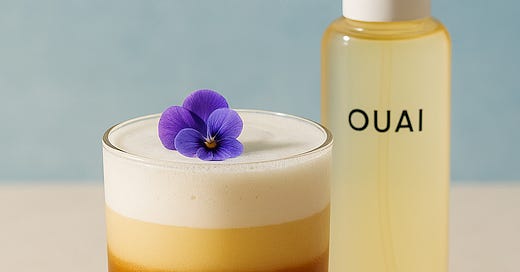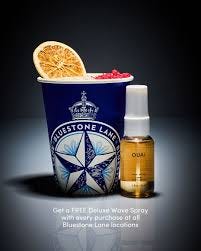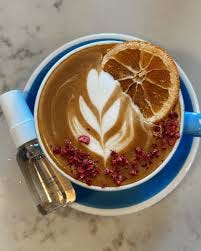Collaborations. So hot right now. Whether it's Nike and Skims, e.l.f. and Liquid Death, or Barbie and Airbnb — they're a fun way to expose your brand to a new audience. But does that exposure make an impact on your brand's bottom line?
Not all brand collaborations are created equal. Some generate buzz but zero dollars, while others quietly build both brands' bottom lines. The difference? Following my $MART Partnership Playbook—five principles I've seen work across beauty, fashion, food, and beyond.
Let me break it down using a collab I just enjoyed in real life: the OUAI-vy white mocha at Bluestone Lane.
$ - Simple explanation
The first rule of profitable collabs: if you can't explain it in 3-5 seconds, it won't sell.
Here's how I'd describe the OUAI × Bluestone collab: "A coffee inspired by a hair product's beachy scent."
And that should be enough. Anything longer or more cumbersome will weigh it down. The best collaborations are intuitive, even when they’re surprising. They pass the "oh, I get it" test instantly.
M - Makes unexpected yet logical connections
On paper, coffee and a hair product shouldn't go together. That's the unexpected part that makes you do a double-take on Instagram.
But here's where the logic kicks in: the scent of OUAI's wave spray (called North Bondi) was inspired by Sydney's iconic Bondi Beach. Bluestone Lane is an Australian-inspired coffee chain bringing those same Down Under vibes to America.
When Bluestone dreamed up the perfect drink to pair with this hairspray, they created a moment of delightful surprise by connecting through their shared Australian beach inspiration. The white chocolate is decadent but light, the softer sister of regular chocolate. The hit of orange lifts it up and gives it that beachy-summery vibe.
It's this collision of unexpected worlds (hair products and coffee) with a logical bridge (Australian beach inspiration) that creates those social media-worthy moments while preserving each brand's core identity.
UNEXPECTED WORLD + LOGICAL BRIDGE =
A MOMENT THAT MAKES US FEEL SMART AS CONSUMERS
Research shows these moderately surprising pairings actually generate higher engagement than completely random or completely predictable ones. Our brains like that little "aha!" moment when we make the connection.
A - Adds complementary sensory dimensions
The brilliance of pairing a drink with a hair product goes beyond clever marketing—it's multi-sensory branding at work.
When I sipped my OUAI-vy white mocha, I was literally tasting what the wave spray smells like. The experience creates a complete sensory loop—the sight of beachy waves in your hair, the feel of texture without stickiness, the scent of the product, and now the taste that complements it all.
The most profitable collabs don't just combine two products—they create a more immersive brand experience by engaging additional senses. When brands appeal to multiple senses simultaneously, consumer recall increases dramatically and creates stronger emotional connections.
This multi-sensory approach isn't limited to taste, either. Successful collaborations might add:
Sound (a custom playlist to enjoy while using the product)
Touch (textural elements that complement the product experience)
Visual dimensions (new ways of seeing the product in action)
R - Right timing
OUAI just introduced the "new and improved" version of its much-loved wave spray with the tagline "Make Waves Wherever You Go."
The collab with Bluestone Lane gave OUAI, a premium beauty brand, a chance to promote this upgrade to premium coffee lovers who might not follow beauty brands on social media. Right product, right time, right audience.
The most profitable collaborations align with key moments in a brand's journey—whether that's a product launch, a repositioning, or a seasonal opportunity.
T - Take-home experience
The best part of this lovely latte, besides the obvious taste and presentation, is the fact that it came with a free sample of the OUAI Wave Spray.
Doing some quick girl math—the travel size Wave Spray costs $16 for 1.7 fluid ounces. And the Wave Spray I got with my latte was 1 fluid ounce, making it a $9.41 value. My latte cost $6.50.
So I basically got paid $2.91 to try this delicious coffee. That's what I call smart sampling.
But the real ROI for OUAI isn't in giving away samples—it's in the conversion rate. What percentage of people who try the sample will go on to purchase the full-size product? That's where collaborations truly prove their worth.
The most profitable collaborations don't just create a moment—they create a pathway to continued engagement with both brands.
The AI Experiment: Putting the $MART Playbook to the Test
Curious about how codifiable these principles really are, I decided to run an experiment. I asked Claude to assemble a dream team of PR and social media experts to brainstorm a collab for a fictional haircare brand with a Bondi Beach-inspired wave spray.
The brief I gave Claude mirrored my $MART framework exactly: make it simple to explain, create unexpected but logical connections, add complementary sensory dimensions, have strategic timing, and include a take-home experience.
What happened next was honestly wild!!!
Without any knowledge of the actual OUAI × Bluestone Lane partnership, Claude's virtual PR team landed on almost the exact same concept: an Australian-inspired coffee brand collaboration featuring a signature drink that complements the scent profile of the wave spray.
They even specifically recommended Bluestone Lane as the perfect partner, citing their Australian heritage, US retail presence, and alignment with aspirational beach lifestyle.
The AI-generated "Bondi Brew" concept mirrored the real OUAI-vy mocha in uncanny ways—focusing on creating a taste experience that complemented the fragrance while leveraging physical café locations for sampling opportunities.
And the final touch? I went over to ChatGPT and used o4 to generate an image for the collaboration based on the description of the drink and the existing OUAI bottle. The OUAI bottle was by far the hardest part to get right — I spent about 2 hours arguing with ChatGPT about what it is currently capable of doing with an existing product shot of a bottle on a white background and inserting it into an image. And I ended up needing to use a combination of the desktop and mobile apps to get it close to realistic, because of some features that are available on mobile are not on desktop (at least at the time of this experiment!). If I put more time into it, I could have gotten this to a perfect place—but it’s good enough to make my point for now:
Why This Matters for Your Brand
The fact that AI could essentially reverse-engineer a successful real-world collaboration tells us something crucial: profitable brand partnerships aren't magical or random—they follow a predictable formula that can be learned and applied.
The $MART Partnership Playbook isn't just theory; it's a repeatable framework for collaboration success:
$imple explanation - Can be pitched in seconds
Makes unexpected yet logical connections - Creates that delightful "aha!" moment so consumers feel clever, too
Adds complementary sensory dimensions - Engages additional senses for stronger recall
Right timing - Aligns with brand moments that matter
Take-home experience - Extends beyond the initial interaction to drive conversion
As brand collaborations become increasingly common (and expensive), the winners will be those who understand these principles deeply and execute them flawlessly.
What's your favorite brand collab lately? Hit reply and let me know which ones you think were truly $MART—and which ones missed the mark. Even better, tell me which one generated actual revenue, not just social buzz.
Until next time,
Kimberly






